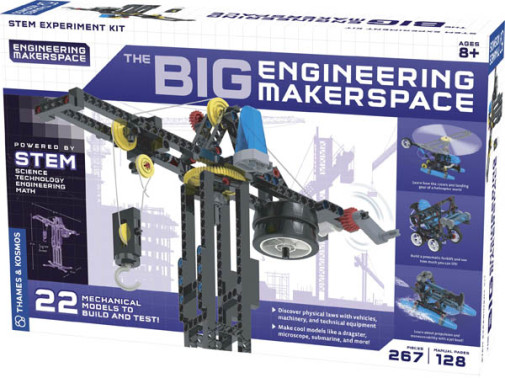We use cookies to make your experience better. To comply with the new e-Privacy directive, we need to ask for your consent to set the cookies. Learn more.
Big Engineering Makerspace
Take engineering skills to the next level with this comprehensive STEM building kit. Focusing on Physics and Engineering, students build functional models and conduct experiments following the activities in the 136-page manual. The fun, however, doesn't stop there! Once the activities are completed, explore even more as you design and build your own models.
The full-color Instruction Manual provides explanations and step-by-step instructions for 22 models. Divided topically, students will build submarines and a catamaran in the water and beach chapter. Dragsters and a tower crane in the land chapter, and a helicopter and windmill in the air chapter. A forklift and hydraulic lift are featured in the engineering in society chapter; and a self-stick and smart phone microscope in the optical chapter. And that is just a sampling of the exciting activities! With over 250 pieces, children will be challenged as they discover buoyancy, wind power, gears, energy conversion, pneumatics, optics and much more!
Parents may need to assist with the more complex builds, depending on the age and skill levels of the builder. You provide a measuring tape, kitchen scales, a board, coins/metal washers, a smartphone, and common household items.
Ambitious in scope, this kit provides an excellent opportunity for students to expand their knowledge of the sciences and discover their inner engineer!
With hundreds of building pieces and more than 20 models and experiments, The Big Engineering Makerspace is a comprehensive and ambitious STEM experience. In five chapters, you can experimentally explore different areas of physics and engineering design by building functional models and conducting tests with them. Explore marine vehicles, submersibles, buoyancy, wind power, rotation, gears, energy conversion, center of gravity, balance, pneumatics, hydraulics, statics, optics, and much more.
In the water and beach chapter, build models of a jet boat, submarine, catamaran, and sail car. In the land chapter, engineer models of a dragster, trike, automobile brake, automobile suspension, and tower crane. In the air chapter, construct models of a helicopter, glider, windmill, and falling leaf. In the engineering in society chapter, assemble models of a forklift, spinning top, hydraulic arm, scissor lift, and distance measuring tool. Finally, in the optical devices chapter, build models of a camera stabilizer, tripod, selfie stick, and smartphone microscope.
In addition to the models described in the instruction manual, you can design and build your own models. The building possibilities in this modular engineering system are virtually limitless. A 128-page manual guides your model building and experiments with step-by-step illustrated instructions.
A learning and playing experience rolled into one, these kits are a fun way to discover and comprehend basic engineering principles. Often the ideas behind why machines work are difficult to explain and understand. That's where these kits can help. By giving children a hands-on building experience while explaining the concepts behind why their contraptions work, understanding things such as kinetic energy, how force is transmitted, and how hydraulics work becomes not only easier but also more engrained into the brain. In each kit, a specific theme is explored, such as gears and transmissions. The child builds 5 - 10 machines that demonstrate each theme and an explanation is given as to how the machines work. Sometimes, concepts are explored in a more experimental way - for instance, in a discussion of how gears transmit force, children twist differently sized gears together to see how that effects the speed of rotation. Each contraption has exploded-view picture directions which are step-by-step and show how each piece fits together. However, younger children may still need adult assistance with some of the more complex projects. - Janine
| Product Format: | Other |
|---|---|
| Brand: | Thames and Kosmos |
| Grades: | 3-AD |
| EAN/UPC: | 814743013414 |
| Length in Inches: | 13 |
| Width in Inches: | 19 |
| Height in Inches: | 3.75 |
| Weight in Pounds: | 3.85 |

